by Winding Pathways | Nov 28, 2024 | (Sub)Urban Homesteading, Foraging
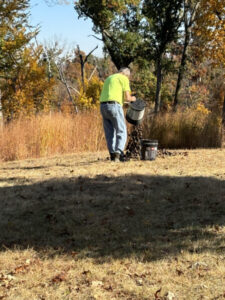
Creating dinner
This fall we borrowed a Nut Wizard nut picker-upper from a friend and helped neighbors harvest gallons of black walnuts. We dumped them in our backyard and, over several weeks, delightedly watched a progression of squirrels haul them off to eat and bury.
They scurried off in all directions carrying a single nut in their teeth. After hundreds of squirrel trips our nut pile was gone. Those ambitious squirrels buried walnuts all over our property.
Derecho Destruction and Re-seeding Nut-Bearing Trees
Most folks don’t want or need walnuts sprouting in their yards but want to clear the yard of various nuts that fall from trees each autumn. The simple answer is investing in a nut wizard or borrowing one. This handy gizmo, which comes in several brand names, rolls along easily capturing nuts that you can then drop into buckets to dispose of. Eastern Iowa suffered a huge tree loss in 2020 when a derecho smacked us with 140 mph winds. Mature trees fell like matchsticks. Since then, we have been “reforesting” timber patches and urban streets and yards. Using a nut wizard to pick up nuts and re-purpose them helps reforest our area. This is a far better option than dumpstering them. A local nature center or park might be a good option to help replant lost trees. Or you can learn to shuck and process nuts for eating.
Squirrels Do the Work
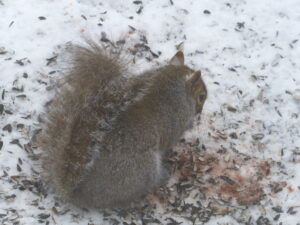
Squirrels bury nuts in caches to retrieve them later.
Back to our squirrels. One morning we watched one use its front legs to dig a hole beneath our window, drop a nut in, cover it with dirt, and pat it neatly down. We’re sure it will be its breakfast on a cold January morning. Not all nuts get dug up, so we expect to find walnut seedlings all over our yard in the coming years.
Nuts An Amazing Food
Nuts are an amazing food for squirrels and people. Unlike most foods, nuts don’t spoil for months. Humans worldwide throughout history harvested walnuts, hickory nuts, filberts, chestnuts, and acorns and put them into storage for delicious eating during food-scarce winters.
Nuts are loaded with protein, oil, fiber, and vitamins. Squirrels, many bird species, deer, bears, and chipmunks have always eagerly gathered and stored wild nuts, but generally people today shun harvesting for good reason.
In past years people gathered and processed nuts. It took time and effort to collect, process, and store them. It’s much work. Planned “nutting parties” were somewhat festive occasions where neighbors gathered to collect and process nuts together. Probably many tall tales and gossip were shared that made the tedious processing more interesting.
Today it’s much easier to buy nuts at the grocery store but wild nuts remain a viable food.
Common Nuts for Wildlife and Human Food
Black Walnuts: Common in suburbia and woods edges, black walnut trees drop messy nuts by the zillions every early fall. Removing the husk, cracking the shell, and picking out the nut meat is a tedious and messy chore that yields delicious additions to cookies and cakes.
Chestnuts: The American Chestnut tree once ranged throughout Eastern North America and produced enormous quantities of nuts that were relatively easy to collect and process. Unfortunately, an exotic blight killed nearly all the trees a century ago. Today similar nuts are dropped from related Chinese and hybrid trees that resist the blight.
Hickories: Pecans are a species of hickory that grow mostly in the south, but Shagbark and Shellbark Hickory have a much wider range and are equally delicious. One hickory, the Bitternut, produces nuts so bitter even the squirrels leave them alone.
Acorns: Oaks worldwide produce nutritious acorns esteemed by wildlife but generally shunned by people. We prefer gathering White Oak acorns and processing them carefully before storing the resulting flour to add to muffins, pancakes, and cookies.
We’ve shared information on how to identify, collect, process, and eat nuts in past blogs. Plenty of information is also online on how to do it.
-
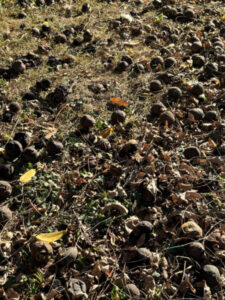
-
Messy
-
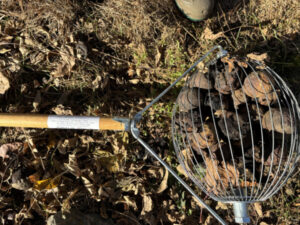
-
Nut Wizard
-
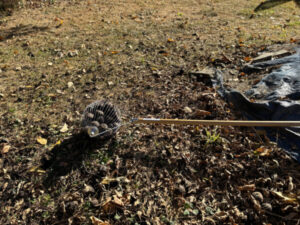
-
Rolling up walnuts is easy.
At Winding Pathways we’re so happy to share walnuts with squirrels that we use a Nut Wizard to collect them in friend’s yards and bring them to ours.
by Winding Pathways | Nov 21, 2024 | (Sub)Urban Homesteading, Mammals, Nature
Flying squirrels are phantoms of the darkness. Are they nearly invisible waifs, ghosts, or fascinating and beautiful mammals? Fortunately, they are real, moderately common in good habitats, but hardly ever seen by people.
Marion recalls her Uncle Bill taking her outside one evening in Florida. Quietly they waited at dusk and suddenly, a petit squirrel launched from a tree and glided past. A thrilling sighting for a seven-year-old and a fond memory all these years later.
For many years a colony of southern flying squirrels lived in a massive hollow elm at the Indian Creek Nature Center. Although their tree was next to a busy trail, daytime hikers never saw the animals. Many times, I’d lead people to the tree as darkness gathered. We’d sit quietly. Just as it became almost, but not quite, so dark that vision was impossible squirrels would appear from a hole in the tree. We couldn’t really see them glide but could hear a rustle of leaves as one landed nearby. Flying squirrels are delightful.
Two Species
Many people live close to them and don’t realize it because they are so nocturnal. Two species live in North America. The northern flying squirrel lives mostly in Canada, and the southern one lives from about the Canadian line south to the Gulf of Mexico, so most people live in their range.
Can They Really Fly?
Flying squirrels are tiny but can’t fly. They are gliders and probably should be called gliding squirrels. A special adaptation, called a patagium, allows them to extend loose skin along their sides to form a sort of wing. This allows them to glide from up in a tall tree to the ground or the lower section of a tree trunk.
They live in woodsy areas with big nut trees, especially oaks and hickories with plenty of fallen trees on the ground. They live in hollow trees. Come late evening they scurry about seeking seeds, mushrooms, bird eggs, and insects to eat. They are omnivores. Their greatest enemy is the Great Horned Owl, also nocturnal.
Conflicting Schedules
It’s ironic that just as people head indoors as darkness descends, flying squirrels emerge so they are rarely seen. Here’s a trick to help people spot the elusive animals.
Flying squirrels love birdseed. They’ll visit a feeder after dark. So will raccoons, opossums, deer, bears, and mice. A feeder can be as busy at midnight as noon.
How You Can Enjoy Sightings of Flying Squirrels
To enjoy flying squirrels and other nocturnal visitors shine a flashlight on the feeder every once in a while, after sunset. With luck, there will be flying squirrels snacking on seeds.
Although many people let bird feeders be empty overnight, we do the opposite and scatter seed on a platform feeder and the ground. It’s a surefire way to attract the night shift.
Photos Are Hard To Come By
We don’t have a photo of flying squirrels because we’re never near the feeder ready to take pictures in the darkness when the squirrels visit. The National Wildlife Federation offers excellent information about flying squirrels. And YouTube has some fun videos to watch on them.
We also enjoy diurnal squirrels that frequent Iowa yards and forests.
by Winding Pathways | Nov 7, 2024 | Birds, Chickens, Garden/Yard, Nature
Cardinals and other birds visiting wintery backyard feeders need grit. They’ll appreciate finding some near the sunflower seeds and millet.
The old saying that something’s as scarce as a hen’s teeth is as true for the chickadees, cardinals, and goldfinches that visit backyards as it is for the hens in our coop. Birds have no teeth. Before they can digest coarse corn and wild seeds it must be thoroughly chewed. How do they do it?
What Is Grit?
Seeing birds along wintery roads solves the mystery. They’re picking up and swallowing tiny pieces of rock that will descend into their gizzard. A gizzard is a powerful muscular pouch that grinds tough seeds against grit, resulting in a seed slurry that then moves through the bird’s digestive system. Grit is a bird’s teeth.
When Is A Good Time to Spread Grit?
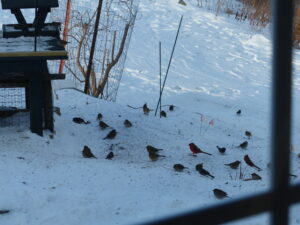
Birds flock to the seeds.
During warm months birds have no trouble finding tiny stones in bare patches of earth, but when the world is blanketed in snow or ice, they can’t find grit. Winter is when they appreciate swallowing a few tiny stones near bird feeders.
What Types of Grit Are Best?
As we fill our feeders at Winding Pathways, we sprinkle grit in with seeds and dribble some on the ground. We use two kinds of grit. When we have it on hand, we prefer baby chick grit that we buy at a farm store. It is tiny pieces of sharp quartzite that’s especially effective in grinding seeds in a gizzard. It’s sized for tiny baby chickens, so it’s just right for backyard feeder birds. When we don’t have it on hand we use regular sand. Traction and kid’s sandbox sand both work well and can be purchased at most home supply stores.
How Much Grit?
-

-
Birds flock to the seeds.
-
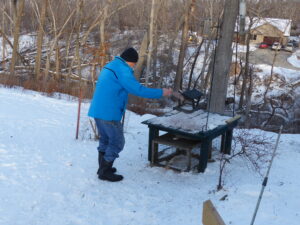
-
Sprinkle grit once a week to help birds in the snowy season.
-
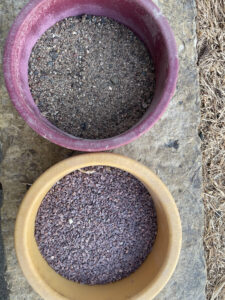
-
Spread grit when the ground is snow or ice covered.
Birds must have grit, but they don’t need much. A handful in and around feeders once or twice a week is plenty.
Other Uses
Grit’s useful around the house. When walkways are snow-slicked humans are mostly likely to slip and fall. Tossing grit on slippery walkways creates traction for people and may prevent a painful fall. Birds spot it there and occasionally pick up a few pieces. We keep about 50 pounds on hand and use most of it for traction and just a tiny fraction for our birds.
This winter when filling bird feeders scatter a bit of grit. Cardinals and other birds will appreciate it.
by Winding Pathways | Oct 24, 2024 | Bugs, Garden/Yard

Wooly bears show up this time of year.
On a warm October afternoon bears were in our yard! Not to worry. They were wooly bears. Caterpillars. We like them and follow them as they scurry along as fast as their tiny legs can go.
Where are they going and how do they know how to get there? The answer to the first is simple. Wooly bears spend the late summer munching on plant debris, but when nights cool, they sense winter’s onset.
A wooly bear wandering around in October is looking for a snug place to overwinter. That could be in a rotting log or tucked under a porch. We often find them in January tucked in between chunks of firewood. When we discover one, we gently move it to another nearby safe spot so we can continue bringing in wood and it can continue slumbering until spring.
How Do Wooly Bears Know?
We can’t explain how they know where to find a place to overwinter. Maybe it’s a random search or somehow, they can sense safe places. It’s a fascinating mystery of nature.
What ARE Wooly Bears?
Wooly bears are cold-blooded, so their “wool “doesn’t help them stay warm. They have an amazing survival strategy. As the temperature drops to freezing a wooly bear’s heart stops beating. Then its gut freezes. Then its blood freezes, and soon the entire insect is frozen solid. Fortunately, frost crystals are outside its cells, so when warm weather arrives the wooly bear thaws and goes about its business.
How Many Species Are There?
There are eight species of wooly bear in North America. The adult phase is called an Isabella moth.
Predicting Weather
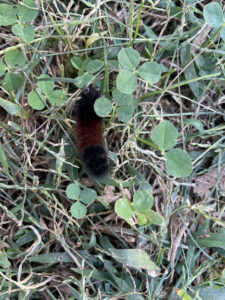
Winter Predictor?
Wooly bears are fun. We love watching them cross our driveway and twist their way through grass stems each fall. Can they predict the severity of the oncoming weather? Some people think so and carefully examine the bands of color on the caterpillar’s bristles that look like wool. We don’t take chances on wooly bear weather predictions and keep plenty of firewood on hand.
Woolly Bear Festival
Vermillion, Ohio, treasures its wooly bears. So do the 150,000 people who attend the Woolly Bear Festival, held annually in late September. It may be the Ohio festival attended by the most people.
by Winding Pathways | Sep 19, 2024 | (Sub)Urban Homesteading, 1080 Labyrinth Blog, Garden/Yard, Nature, Wonderment
Partnership with Sustainable Landscape Solutions Creates Natural Beauty
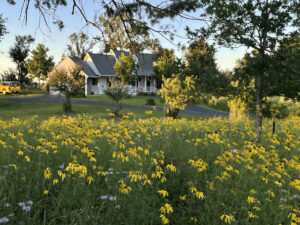
Brilliant flowers
When we bought our home near Cedar Rapids in 2010 we had a vision to transform the yard that had been sprayed and manicured by its former owner into a wondrous place, brimming with natural beauty and fascinating wildlife. It would be a delightful yard with prairie and savanna wildflowers bouncing in the breeze, and goldfinches and swallowtail butterflies winging over. We sought to create natural beauty.
We have years of ecological restoration experience. Rich had been restoring prairies and oak savannas since 1975 in his position as executive director of two nature centers. Like Rich, Marion is an inspired naturalist and a labyrinth expert. Together we had managed our former home for diversity, but the new property offered more space.
Beginning almost immediately, we planted prairies in portions of our front and back yards and worked with Linn County Roads to restore prairie in the nearby road ditch. This helped hold runoff water that could percolate into the ground.
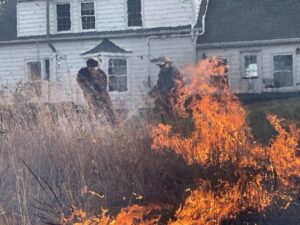
Working together.
Fortunately, we have experience managing fire. Rich is a former US Forest Service Hot Shot (wild firefighter) and we’ve used prescribed burns to help nurture the prairie. Burning has helped us resurrect native plants and wildlife.
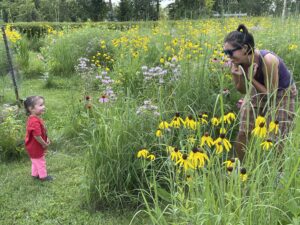
August – Joy is a part of labyrinths.
In their largest prairie Marion crafted the Phoenix Harmony Labyrinth. This is a five-circuit, dual-entry path to the center where people can enjoy a bur oak and be surrounded by prairie grasses and forbs. She welcomes people to play and encourages anyone wishing for moments of contemplation to visit and walk its curving paths between blooming prairie plants. Her labyrinth is listed on the international labyrinth locator registry.
How Sustainable Landscape Solutions
Helped the Pattersons
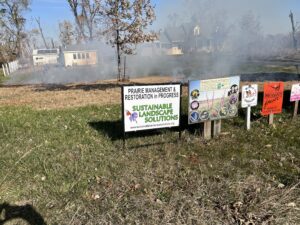
Several organizations and businesses are collaborating to create and manage the prairie.
We needed help with our newer projects. “We wanted to transform a hilly patch of our front lawn into a prairie rich in wildflowers and fewer tall prairie grasses. The site was a long-established conventional lawn composed of exotic grasses,” said Rich. “That’s a challenging environment to establish prairie. I’ve established prairies on lawns before by broadcasting seeds and following up with prescribed burns. But, it’s a slow process. We wanted to speed up restoration and needed help killing the turf and preparing the soil,” he added.
In 2020 we hired Sustainable Landscape Solutions to do the prep by first spraying the existing turf and later working the soil. Pattersons took it from there and planted a seed mix they purchased from Pheasants Forever. It’s called their Leopold Mix and contains seeds of 82 species of native prairie wildflowers.
Patience
It takes prairie time to mature. A year after planting we had a few blooms. The next year a few more. In its third year, it began to look like a prairie, and by its fifth growing season, the area was a magnificent spread of colorful flowers fluttering in the summer breeze. Alive with bumblebees, butterflies, and other insects, it was rich with life.
Next Steps
Four years later we decided to pursue a different sort of property upgrade. The 2020 Derecho did a job on a cozy nook next to the garage. “We wanted to transform a weedy nook south of our house into a delightful place to sit on cool spring and fall days where the sun would warm us. We worked with Virginia Hayes of Sustainable Landscape Solutions to come up with a patio plan that allows us and our visitors to sit and enjoy our thriving natural landscapes.
Patience, Again
Multiple rains delayed the project as Sustainable Landscapes worked diligently to catch up on already scheduled, and now rain-delayed projects. The new patio was crafted in July 2024. “It’s an example of how our company was able to work with homeowners to create a vision and gorgeous yard. Pattersons had much restoration knowledge but we’re happy to help people less experienced transform their yards into areas of natural beauty,” said Sean Pearl of Sustainable Landscapes.
-

-
Weeds overtook the area
-
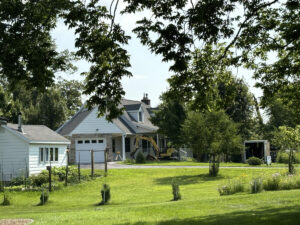
-
Small evergreens have replaced fallen Derecho trees.
-

-
First removing dirt.
-
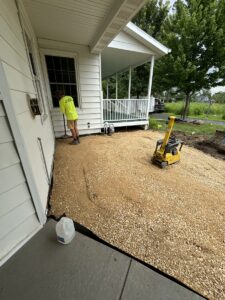
-
Next steps
-
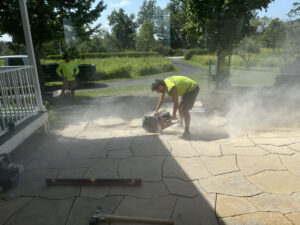
-
Dusty job
-

-
Water flows away

Coming together
Now, in early autumn, the nook is coming together nicely and we look forward to sharing it, the yard, and the labyrinth with others.
A Little More About Labyrinths
The Patterson’s labyrinth is created in a tallgrass prairie but these can be built in many ways, including in formal landscaping. “Many are made of bricks or pavers that enable a walker to negotiate the winding pathway,” said Marion. “Ours has a wide grassy path with borders of prairie grasses and forbs that change seasonally.” Labyrinths are structures with a path that winds to a center. Each time walkers follow the path around the center is called a circuit. Walkers find that the winding path slows down their minds and they can settle into a more relaxed space. Because of the natural setting, many walkers comment on how they recall times in nature as youth. Patterson is available to help landowners create labyrinths.
Blessings of the Changing Landscapes
We welcome visitors to our Winding Pathways website and to see our prairies.
by Winding Pathways | Sep 5, 2024 | (Sub)Urban Homesteading, Foraging, Mammals
A few years ago, after seeing many squirrels with nearly naked tails we researched and posted a blog in February 2022. Furless Tailed Squirrels.
The response amazed us. People from around the world visited it and still do every day. We had no idea this condition was so widespread.
So, we’re posting a follow-up. Two winters have passed and our squirrels now have perfectly normal furry tails. We’re unsure if older squirrels have regrown fur or if the new generation never had the condition. Since most squirrels don’t live for more than a few years, we will likely see younger animals.
Whatever conditions caused them to lose their fur seem over. That’s not unusual in wildlife populations. If a serious disease or calamity reduces the population the condition subsides and survivors reproduce with enthusiasm, rapidly restoring abundance.
Based on our website traffic we suspect furless-tailed squirrels have been found far and wide. We predict that they, like our Iowa squirrels, will rebound with healthy furry-tailed animals.
A Short Squirrel Primer
Although many people dislike squirrels for their habit of gobbling up feed intended for birds, we like them. Squirrels are just as fascinating as goldfinches or cardinals, so we put out enough seed for both.
During the 2024 Summer Olympics, we were thrilled watching the graceful and powerful movements of Simone Biles, other gymnasts, and pole vaulters like, Armand “Mondo” Duplantis.
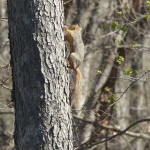
What happens when a squirrel falls?
We’ve not heard of a comparable competition for squirrels, but they are also amazing gymnasts and vaulters. In our yard a small oak and a large walnut live next to each other. Every fall the walnut is loaded with nuts that tempt squirrels. We love watching them climb the oak to its tippy top and then make an amazing upward leap to a flimsy walnut twig above. Like human gymnasts and vaulters, squirrels have impeccable balance, flexibility, strength, determination, and courage.
Treetop leaps aren’t always successful. Twice we’ve seen squirrels slip off high oak branches and fall 30 or 40 feet to the lawn below. Both times the hapless animals spread eagle, landed with a thump, and scampered off apparently uninjured. They are an amazing animal.
Late Summer Activity
As we write this in late summer walnuts and acorns are maturing. People may not like squirrels but these trees need them so much their annual nut crop is a bribe. Squirrels eagerly gather and eat many of the nuts but they scamper off and bury some, often a long way from the parent tree. Some nuts are never dug up and become a new tree generation. The exchange is a good deal for both trees and squirrels.
The rodents get nutritious food. Walnuts and acorns get free tree planting. Both win.
Hopefully, anyone reading this is enjoying squirrels that have grown fur on their once furless tails. Enjoy these amazing animals. To learn more about squirrels visit Animal Diversity.






















